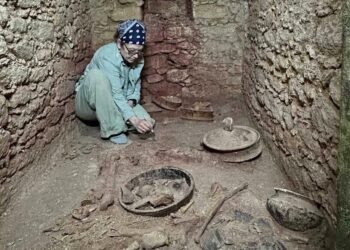Archaeologists have unearthed a hollowed-out animal bone containing hundreds of black henbane seeds sealed with a black birch-bark tar plug, at the Roman-period settlement of Houten-Castellum in the Netherlands. This finding provides the first conclusive evidence of the intentional use of black henbane as a medicinal or narcotic substance during the Roman era.
 The significance of this discovery lies in its confirmation of ancient texts’ descriptions of black henbane’s medicinal and hallucinogenic properties. Black henbane, scientifically known as Hyoscyamus niger, belongs to the nightshade family and is notorious for its toxicity. Roman historian Pliny the Elder and Greek physician Pedanius Dioscorides both documented the use of henbane during antiquity. Pliny described it as “of the nature of wine and therefore offensive to the understanding,” while Dioscorides recommended it as a sedative and analgesic.
The significance of this discovery lies in its confirmation of ancient texts’ descriptions of black henbane’s medicinal and hallucinogenic properties. Black henbane, scientifically known as Hyoscyamus niger, belongs to the nightshade family and is notorious for its toxicity. Roman historian Pliny the Elder and Greek physician Pedanius Dioscorides both documented the use of henbane during antiquity. Pliny described it as “of the nature of wine and therefore offensive to the understanding,” while Dioscorides recommended it as a sedative and analgesic.
Lead author of the research, Dr. Maaike Groot from the Freie Universität Berlin, emphasized the importance of considering the context of such findings in distinguishing between naturally occurring plants and those deliberately used by humans. She explains, “The find is unique and provides unmistakable proof for the intentional use of black henbane seeds in the Roman Netherlands.”
The bone container, likely originating from a goat or sheep, was dated to the first century CE, based on associated artifacts found in the same pit. The presence of the seeds within the bone, along with the seal made of black birch bark, suggests a purposeful act of storing and preserving the plant.

The discovery also sheds light on the spread of medical knowledge in antiquity, as the site near Utrecht, on the far fringes of the Roman Empire, demonstrates local awareness of medicinal plant species. The researchers noted that while the plant grows naturally in disturbed soil near settlements, the sealed bone container provides solid evidence of human interaction with the plant.
This finding challenges previous assumptions about the use of black henbane during the Roman period, highlighting its significance as both a medicinal and narcotic substance. The study was published in the journal Antiquity.























